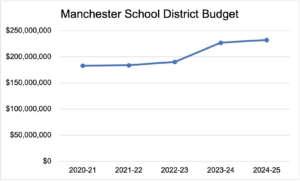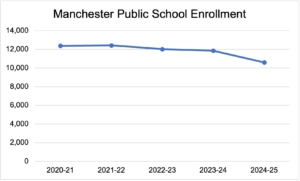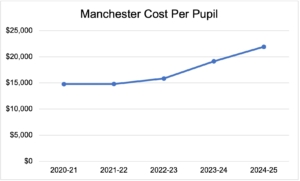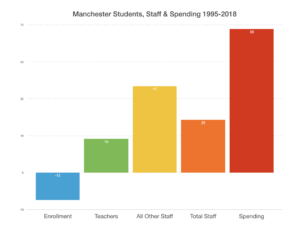Kay is a 63-year-old single mom in Manchester who would love to be able to retire in the next five years. But as things stand, she doesn’t think she’ll be able to. Her adopted son needs the kind of high school environment they haven’t found among area public schools. And she needs to find the funds to pay for what he needs.
Kay and her late husband adopted their son from Kay’s husband’s niece. The niece, who struggled with addiction, had three children adopted out. Two were adopted through child protective services and eventually wound up with a grandparent, Kay said. Kay and her husband adopted their son directly, so there were no financial stipends.
In 2019, Kay’s husband died unexpectedly, and she decided to move back East from the Southwest to be closer to family for support, she said. Kay, her son, and two daughters call Manchester home.
Under the income cap legislators set for the Education Freedom Account (EFA) program, Kay’s single-mom family is classified as a “family of four,” which is presumed to have two parents and two children. That classification has put her son’s educational needs just out of reach.
Kay is a sales professional with a good job. But sales work is not always steady work in a changing economy. After she was recruited to work for a New Hampshire company, things seemed to be settling down for the family, but six months after the relocation, and two weeks before Christmas, Kay was laid off, she said.
She joined a new company in April 2023, and three months later, due to market conditions and a company restructuring, she was again laid off.
For a single mom raising a teenage son and two older daughters that she’s put through college, the money, even when it’s steady, goes fast. Even today, she’s still catching up on finances from the layoffs, she said.
State law caps Education Freedom Account eligibility at 350% of the federal poverty level. For a family of four, that’s $109,200. Kay’s salary from her new job puts her $90 over the cap, she said.
On the state’s spreadsheet, Kay’s family of four looks like a family with two working adults and two children. The spreadsheet doesn’t know the difference between that typical family and a single mom with three children.
When Kay decided to move to Manchester for its perfect location between her work and the customers she serves in Boston, she didn’t realize the challenges in the local public schools, she said. Having lived in the Southwest for years, the cost of many local private schools was another surprise.
Unable to afford a private school for her son, Kay enrolled him in a public charter school in Manchester for 7th and 8th grade. But, given her son’s unique needs and background, she’s seeking a new environment with more resources that could be dedicated to him, she said.
“He has suffered a lot of loss, has ADHD, is in counseling and needs a positive environment with resources,” she said. “He’s a wonderful kid, but needs good examples in other students, leaders, academic support, and a school with athletics and activities.”
The charter school has done the best it can with the resources it has, and there are great people working there, Kay said, but it just isn’t the right place for her son.
In search of a different setting for her son for high school, a Catholic school in Manchester came highly recommended. On a tour, they met with several teachers, administrators, coaches, and even students.
“When we toured, he got in the car and said, ‘Mom, this is my school…everyone is so nice,’” Kay said.
Her son is very excited for robotics and sports. He’s motivated by the support he’d get to excel, she said. The school has academic coaches who will help him with studying, focus and time management, which Kay said was critical for him. The school has a guidance counselor who told her son, “I will be here for your four-year journey to set you up for success in college,” Kay said. She also thinks that the spiritual focus will be a positive influence given the things he is exposed to in a big city.
When she learned about the Education Freedom Account program, Kay thought it would be the answer to her son’s educational needs. But the income cap has kept them locked out. It sees her family as a two-parent, two-child family, not a single mom with three dependents who works in an industry where layoffs are a common risk.
“I get emotional about this because it upsets me that only your W2, not life circumstances, are taken into account when applying for financial aid with schools or education funds,” she said.
When one of her daughters is no longer a qualified dependent, Kay could apply for an EFA as a family of three. But she would again be over the 350% cap, which is currently $90,370 for a family of three.
With an income cap of 425% of the federal poverty level, though, Kay’s family would qualify both as a family of four (a $132,600 cap) and as a family of three (a $109,735 cap). The 425% cap is the limit set in the conference committee version of House Bill 1665.
Without a higher income cap for the EFA program, Kay said she’d take a second job to make the tuition work if she had to. Her daughter is prepared to switch to part-time at New Hampshire Technical Institute to cut the family’s costs, she said. They’d try to make things work, but it wouldn’t be easy.
She would sell her home and downsize, but high interest rates and lack of available homes on the market make that an unrealistic option.
For Kay’s family, the EFA income cap is keeping a perfect educational option just out of reach. A cap designed for traditional families has put a single mom in the position of getting a second job to pay for the education that’s right for her son.
In trying to limit EFA access to families in need, legislators have left out families in need who don’t fit the preconception of what a “family of four” or “family of three” looks like.
As other families will be doing this week, Kay said she and her son will be watching the EFA vote on Thursday with hope. If the income cap isn’t raised, she said she’ll become an activist to push for universal eligibility next year. The difference an EFA could make for families like hers is too important for her not to get involved, she said.













